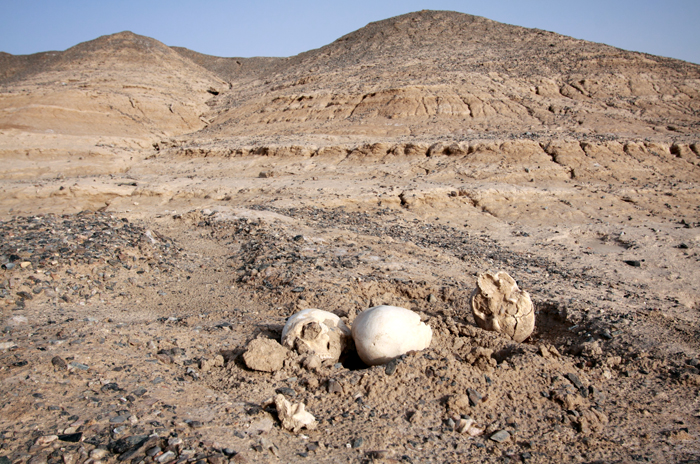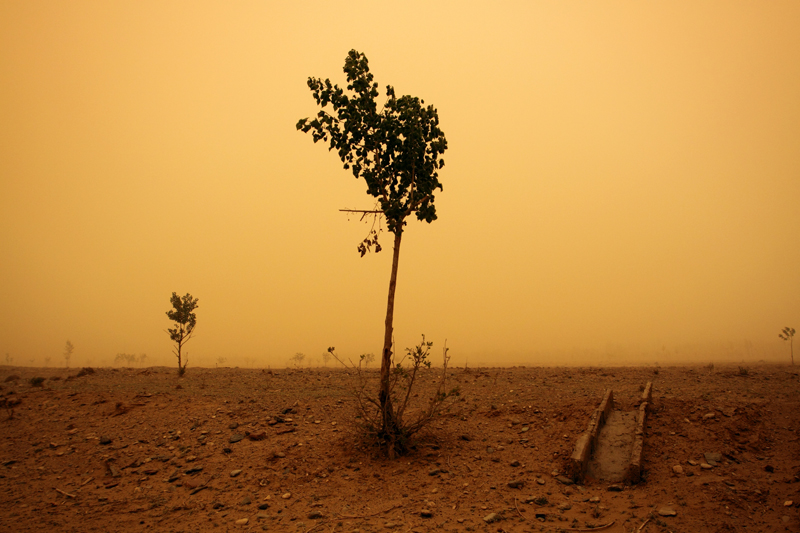Condemned to Repeat?
Ecological disaster bad enough to destroy people has happened before. The only difference was the limited technology of the times, and therefore the limited scope of the dying.
Sean Gallagher has a striking report, a series of pictures each worth thousands of words.

That was then. Two thousand years ago, Yinpan in Central Asia was a major stop on the Silk Road. The water table changed. People couldn’t or didn’t adapt, until the water –and the people — disappeared over a thousand years ago. Soil erosion still uncovers traces of them, but the water never came back.
This is now.

A dust storm raised from the desertified former farm land in China. Life stops. If you have to go outside, you wear a dust mask and choke. The dust is fine as talc and gets everywhere. It’s in your toothbrush, your clothes, your dishes. It clogs your car, it ruins machinery, it gums up your mp3 player. It costs money. It shortens lifespans. The dust travels for hundreds of miles, blanketing Beijing during dry seasons, and sometimes even making murk in the skies of the Western U.S.
The earliest signature of anthropogenic global warming was polar and nighttime warming. We got that, but we’re not polar bears so it wasn’t important. One of the next symptoms is higher temperatures in the middle of large continents. That’s where most of the world’s grain grows. Places like Kansas won’t just be hot in the summer. They’ll be hot enough for old people and babies to die. Plants will wither in the heat no matter how much they’re watered. And it won’t take long before there’s nothing to water them with. If people can’t or won’t adapt, the water table will sink lower and lower. The surface will get drier and drier. There will be dust storms.
Then there’s the future. Photo #1 will describe the future as well as the past.
And you know what’s the worst of it? It doesn’t have to be that way. It Does Not Have To Be That Way. This isn’t the sun going nova on us and frying all life on earth no matter what we do. This isn’t beyond our control. Yet. All we’d have to do is little things, lots and lots of little things, all together, all the time. Nothing heroic, unfortunately. Just wimpy stuff like cooperation and keeping promises.
Sometimes, when the alternative is photo #1, people can do the most amazing things. Even work together.
Here’s just one example of a small unheroic thing that could be part of the solution. I saw this in the news recently.

1) A new, small-scale way of making electricity from wave power. It’s more or less a buoy that bobs up and down, has some gizmos to harvest the energy of the bobbing, and some failsafes in case of storms. It’s easier to maintain and less sinkable than huge megawatt projects, and units can be chained together to yield more power.
2) When a weak electric current is applied to metal scaffolding in seawater, limestone precipitates out of the water onto the metal where it builds up for a while, until the encrustation is thick enough to insulate the current. But — there are two important buts — some limestone forms and the scaffold is colonized by corals if it’s an area where they can grow. It’s not clear yet whether the current helps the corals to grow, but since something to grow on is their limiting factor, some scaffolds mean more corals than no scaffolds. (More here and here.)
Why does that matter, aside from the fact that corals are gorgeous? They’re basically blocks of limestone with a film of life on the surface. And that matters because limestone is calcium carbonate. CaCO3. A molecule of carbon dioxide (CO2) goes into every molecule of calcium carbonate.
Imagine fleets of those pontoon wave power things, towing their webs of scaffolding. Besides generating some energy and helping corals to grow, carbon dioxide would be taken out of circulation, one tiny invisible bit at a time. Imagine millions of wave power pontoons, doing this. And when the weight of all those corals and barnacles and whatnot made the thing sink, we’d float out another one. And another one, and another one.
Same as with all the other things we have to do to reverse global warming, it would cost some money and we’d have to keep doing it, all together, all the time. That’s all.


